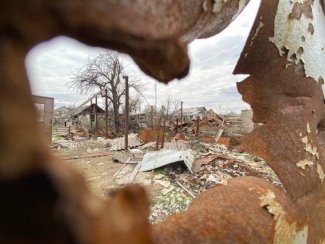The first major missile attack on Ukraine since winter. Day 428 of the war

On the night of 28 April, the Russians launched a rocket attack on several regions of Ukraine. Residential buildings were hit in Dnipro, Uman and Ukrainka (Kyiv oblast), resulting in the deaths of more than a dozen people (10 in Uman alone) and injuries to a further dozen. Local authorities also confirmed strikes on a company and a construction base in Dnipro and a storage base in Uman. Kyiv reported damage to power and road infrastructure from falling debris (the first attack on the city since 9 March). The Ukrainian General Staff reported that its forces had shot down 21 of the 23 Kh-101/Kh-555 cruise missiles which the attackers had fired from their strategic bombers, as well as two drones. The previous day, Mykolaiv came under attack from four Kalibr missiles, the first such strike in 113 days. As a result, part of the city temporarily lost energy supplies.
The Ukrainian forces’ hinterland is under constant attack. Russian rockets hit Kupyansk in Kharkiv oblast, and Druzhkivka and Kostiantynivka in Donetsk oblast. On the evening of 25 April, the invaders also carried out an attack near Zaporizhzhia in which drones were used (the defenders reported shooting down seven of them). Russian artillery and aviation continue to shell and bombard the contact lines and border areas. On 25 April, the local Ukrainian command reported a record 432 shellings of defender positions around Kupyansk, while at the same time the Russian artillery struck 280 times in the Bakhmut area. The frequency of shelling in the Zaporizhzhia region has also risen. Outside the combat areas, its main targets are still the Ukrainian positions in the right-bank part of Kherson oblast (where nearly 400 shells per day are falling) and in the Nikopol region of Dnipropetrovsk oblast. Ukrainian shelling has been reported from Tokmak in the Zaporizhzhia region, and further acts of sabotage have been reported from Melitopol and Russia’s Bryansk region.
The invaders have continued to gradually push Ukrainian forces out of the western part of Bakhmut, and they have renewed attacks on the town’s southwestern outskirts in an effort to further obstruct communication with it. The activation of Russian units located northwest of Bakhmut, mainly in the area of the town of Chasiv Yar, have not had any significant effect. The Ukrainian General Staff reported that the Russians had been repulsed near the village of Novomarkove; that suggests that they had reached the Donets-Donbas canal in that area. This village lies on the western side of the canal; in previous months Russian forces had crossed it southwest of Bakhmut, from where they have periodically been launching attacks towards Kostiantynivka. Successive Russian assaults on the outskirts of Avdiyivka and southwest of the town, in Mariinka and Krasnohorivka, which lie north of it, and southwest of Kreminna appear to have failed. According to the Ukrainian General Staff, the number of hostile attacks – after falling off earlier in the week – have once again risen to an average of 60 per day. Local Ukrainian sources report that enemy forces are being reinforced in the Mariupol and Melitopol areas, and that fortifications in the Zaporizhzhia region are being progressively expanded.
On 26 April, the Polish prime minister and defence minister confirmed that the service and overhaul centre at the Bumar-Łabędy plant in Gliwice, Silesia for the Leopard-2 tanks (the 2A4s and 2A6s) destined for Kyiv will begin operation in May. T-72 tanks will also be serviced there. Considering the earlier agreement to service and overhaul T-64 tanks, it should be said that the vast majority of the Ukrainian armoured forces’ armaments will be serviced in Silesia (there is no information on where the British Challenger-2 tanks will be serviced). A second production line of Krab cannon howitzers will also be launched at the company (the first one is operating at the Stalowa Wola steelworks). On the same day, local media in Slovenia reported that the country had secretly handed over 20 Valuk wheeled armoured personnel carriers (Austrian Pandur-1 vehicles upgraded by the Slovenian Army) to Kyiv in mid-April.
On 27 April, the commander of the Ukrainian Air Force, General Mykola Olyeshchuk, announced that a second squadron equipped with Patriot air defence systems had begun combat duty. Ukraine’s foreign partners have delivered two Patriot batteries to Ukraine, which could be integrated into two different air defence squadrons. The Ukrainian side’s repeated reports about squadrons rather than batteries should also be seen as a deliberate suggestion that Kyiv has received more Patriots from the West than had previously been announced.
On 26 April, Ukraine’s interdepartmental media platform, the Military Media Centre, which brings together communiqués from structures responsible for state defence and security, presented its assessment of the Russian objectives at the current stage of the war and the forces gathered for operations in Ukraine. In the near term, the enemy’s main task is to drive the defenders out of Bakhmut and take full control over it, and to do likewise in Avdiivka and Mariinka. Russia has reinforced its troops with another regiment. Currently, 48 brigades and 122 regiments are taking part in the combat operations against Ukraine, with 315 formations comprising the occupation forces. A total of 369,000 military personnel and 5900 heavy weapons have been assembled to fight the Ukrainian forces.
Also on 26 April, in an appearance before the US Congress, Commander-in-Chief of NATO’s Combined Forces in Europe General Christopher Cavoli gave his assessment of the military situation. He also referred to the scandal over the leak of US intelligence data which has been unfolding over the last few weeks. He stated that according to the modelling carried out, the Ukrainians are in a good situation. In doing so, he confirmed that cooperation with the Ukrainian side in planning their activity was ongoing. Assessing the invaders, he announced that most of the Russian army has still not been involved in the conflict. Russia’s ground troops have been “degenerated somewhat” by the war, but are now expected to be larger in number than at the start of the invasion, and still maintain most of their potential. The Navy has lost one ship (the missile cruiser Moskva) and the Air Force “only” about 80 planes, although 1000 fighters and fighter-bomber aircraft are still “ready for battle”. In the North Atlantic, Russia’s submarine fleet is said to be the most active in years, with patrols operating “at a high level most of the time.” CNN’s report on the speech annotated it with Pentagon data (from late February and early March) showing that 527 of the 544 battalions of Russian land formations were involved in military operations, with 474 of them in Ukraine. Between 35,000 and 43,000 Russian troops are said to have died in the war.
In an interview with CNN on 25 April, Ukraine’s foreign minister Dmytro Kuleba said that there is a lack of political will within NATO on Ukraine’s accession to the Alliance. As he put it, NATO membership will not end the war, but it will help prevent wars in the Euro-Atlantic region in the future; as long as Ukraine remains outside the Alliance, he said, the risk that Russia will repeat its aggression remains. Referring to a possible peace deal, he stated that Kyiv is ready to discuss any initiative that does not involve freezing the conflict on the frontline and making territorial concessions.
Also on 25 April, the Russian defence ministry accused Kyiv of violating the grain deal, claiming that Ukrainian forces had carried out attacks on the Black Sea Fleet base in Sevastopol and on civilian infrastructure on 23 March and 24 April. Ukrainian surface drones apparently took advantage of the humanitarian corridors used to export Ukrainian agricultural products. Ukrainian military intelligence spokesman Andriy Yusov said the attacks in occupied Crimea only targeted military installations, and in no way violated Kyiv’s obligations related to the operation of the grain corridor.
On the same day, Commander of the Combined Armed Forces of Ukraine Serhiy Nayev estimated that the Russian forces deployed in the southern part of Belarus and in the territories of Bryansk and Kursk oblasts totalled about 17,000 men. About 2800 Russians who are part of a regional group of Belarusian and Russian troops are stationed at Belarusian training grounds, and aircraft and helicopters of the Russian Air and Space Forces are still located at airfields in that country. A day later, the command of the Armed Forces of Ukraine announced it had completed the evacuation of most residents of the border regions in Sumy and Chernihiv oblasts. Some elderly people have decided to stay put even though the Russian military is shelling the villages there, treating Ukraine’s border area as a training ground for their artillerymen.
Also on 25 April, British military intelligence reported that the rate at which the Russians are losing men fell in April compared to previous months; they attributed this change to a decision to go on the defensive. It cited data published by the Ukrainian General Staff, which showed a drop in Russian losses from an average of 776 per day in previous months to 568 in April. It was noted that the British analysts could not verify the methodology used by the Ukrainian military, but considered that the trend indicated was likely to be accurate.
On 27 April, the British Defence Ministry announced that 14,000 Ukrainian soldiers have already been trained in the UK. It announced that British military support to Kyiv this year will amount to £2.3 billion.
On 26 April, the chairman of the Russian State Duma’s defence committee, Andrei Kartapolov, said that the inclusion of volunteer militia formations in the protection of the state border should be considered. In doing so, he pointed out that the threat from Ukrainian sabotage has increased. He acknowledged that the FSB border service has insufficient forces to effectively seal the border. Introducing volunteer militias will require rules for the operation of such formations to be drawn up, as well as defining whom they will be subordinate to: the regional authorities or the FSB.
Also on 26 April, Ukraine’s deputy defence minister Hanna Malar reported that a Russian operation to eradicate Ukrainian national identity is underway. The Russian authorities have attempted to change the ethnic composition in the occupied territories, to which large groups of impoverished people of different nationalities are being resettled. The occupation administrations are providing the newcomers with housing, employment and favourable loans to buy housing or run businesses. According to Malar the local Ukrainians, especially those suspected of being hostile to the occupiers, are being deported to Russia under various pretexts.
A decree by President Putin authorising the deportation of residents of temporarily occupied Ukrainian territories who have not accepted Russian citizenship was published on 27 April. Citizens of Ukraine or holders of ‘passports’ issued by the puppet ‘people’s republics’ incorporated into Russia must either become Russian citizens or declare that they do not wish to accept Russian citizenship. Those who choose the second option will be considered foreigners as of 1 July 2024, and will be eligible for deportation. A separate paragraph of the decree deals with the deportation of those who pose a threat to Russia’s national security.
On 25 April, independent Ukrainian journalists reported that the number of fee-paying students (82% of whom are male) at universities there had increased by 40%, possibly to avoid mobilisation. They pointed out that the number of male and female students under the age of 20 at universities has fallen, while the number of students aged 30-50 has increased. According to the law, students receive a deferral from mobilisation during martial law. At least 85,000 men of draft age have taken advantage of the opportunity to begin paid studies in the 2022/3 academic year. According to the education ministry, it cannot be ruled out that if necessary, the military command will initiate changes to the current law, and students will then be mobilised.
Another POW exchange was held on 26 April. 44 Ukrainian soldiers were returned from Russian captivity, while the Russian defence ministry reported that Ukraine handed over 40 captives in return. Since the beginning of the invasion, 2279 Ukrainian citizens have been freed.
On 27 April, Putin ordered the transport ministry to begin the mass production of drones. According to Andrei Belousov, a deputy prime minister of the Russian Federation, the value of government orders for drone production in 2024-6 will run to about 92 billion roubles, to rise to 200 billion roubles (about $2.5 billion) by 2030. The government proposes to create a system of tax incentives for drone manufacturers.
Commentary
- The targets for most of the missile strikes on 28 April allows us to assume that the Russians were attempting to disorganise Ukraine’s preparations for its counteroffensive. Unlike the rocket attacks observed in the autumn and winter, these were not directed against the energy infrastructure; or at least it was just a sideline to the designated targets (the cutting off of energy supplies in Mykolaiv was most likely accidental; the power line in Kyiv was supposedly damaged by falling debris). Although the Ukrainian side has publicised the strikes on residential buildings, these are more likely to have been accidental, especially when juxtaposed with the attacks observed a year earlier, which resulted in dozens of deaths in one place.
- Putin’s decree shows that the Kremlin has decided to finally ‘regulate’ the status of the occupied territories’ residents. Those who resist the occupation authorities or refuse to accept citizenship will be deported beyond Russia. The administrative action is intended to ‘purge’ the occupied territories of those deemed unreliable by the authorities. The idea is that this will lower the potential for Ukrainian sabotage in the Russian-occupied territories and ensure the smooth conduct of the local elections scheduled for this September. Moscow wants to replace the ‘disloyal’ Ukrainians in these territories with indigent Russian citizens from regions in Russia’s hinterland.




